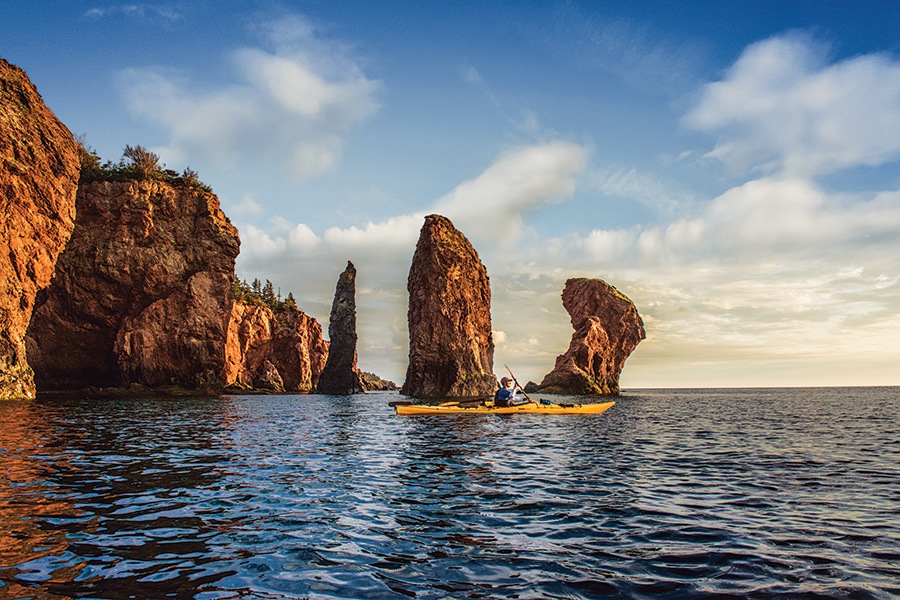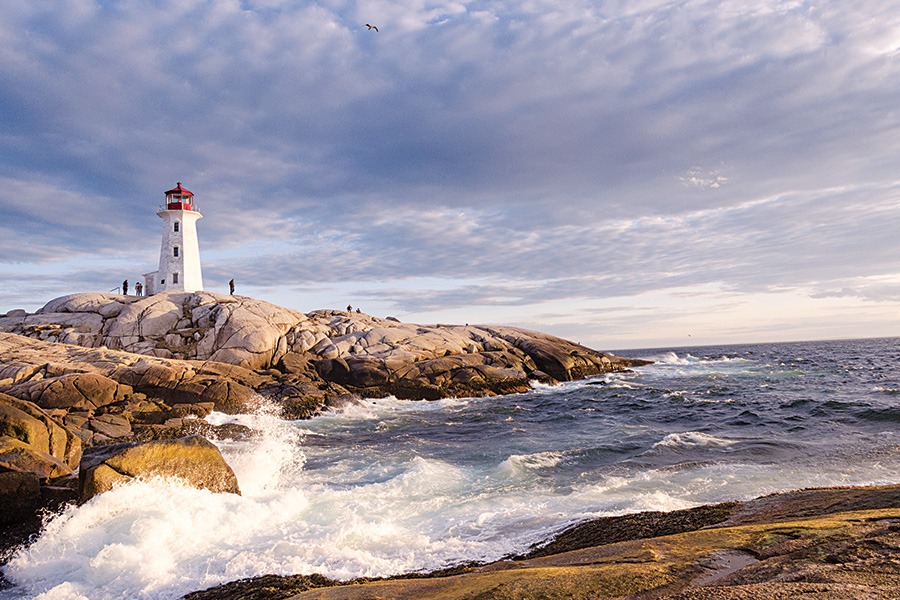A New England Traveler’s Guide to Nova Scotia
The best time to explore this delightful Canadian province less than a two-hour flight from Logan? Right about now.

A picturesque scene on the Bay of Fundy. / Photo by Scott Munn/Tourism Nova Scotia
Lots of people know about Nova Scotia’s natural wonders—the world’s most drastic tides, the dramatic cliffs and rock formations. Some even know why Nova Scotia ships us a Christmas tree for the Common every year: In 1917, Boston sent emergency aid after two ships collided in Halifax Harbor, causing the biggest non-nuclear detonation in history. But the tiny Canadian province is also a treasury of architecture, culture, and history. It’s where the Cajun people of Louisiana’s bayous originated and where thousands of Black loyalists were relocated by the British after the American Revolution. It’s home to distinctive lighthouses, a lush wine-growing region, and six UNESCO World Heritage sites. In short, it’s fascinating, beautiful, and well worth a visit, especially in the mild summer months.
PLAY
The famed Cabot Trail is Nova Scotia’s most popular tourist route, but a less crowded way to discover many of its secrets is a road trip tracing a loop from Halifax to the south. Before leaving the capital, must-see highlights include the star-shaped Citadel, the hilltop fortress commanding the city; the Maritime Museum of the Atlantic and its unparalleled collection of Titanic artifacts; and the boardwalk that winds along the waterfront. A mere hour to the south is Peggy’s Cove and its famous lighthouse—one of the most Instagram-worthy sites in the region—and another hour-and-a-half brings you to the historic port of Lunenburg. A mix between Provincetown and Bar Harbor, its streets are lined with historic mansions, and the main wharf is home to the legendary schooner Bluenose II, which graces the Canadian dime. Further along the coast lies Birchtown, where thousands of freemen and escaped slaves created the continent’s largest free Black settlement in the 1780s. The Black Loyalist Heritage Centre beautifully conveys this overlooked chapter of history.

The iconic Peggy’s Cove lighthouse. / Photo by Gerald Zaffuts/Getty Images
To experience the ancestral land of the Mi’kmaq in all its unspoiled glory, cut inland and north through the Tobeatic Wilderness Area, designated by the Starlight Foundation as one of the world’s best places for viewing the night sky. Continuing north, you’ll emerge in wine country that’s every bit as beautiful as Napa or Sonoma. The vineyards were originally planted by French settlers who were later deported by the British and relocated to Louisiana, where their “Acadian” identity morphed into “Cajun,” but the same joie de vivre persists in towns like Grand Pré and its eponymous winery. Finally, travel to the Shubenacadie River to go tidal-bore rafting on waves up to 13 feet high, thanks to the Bay of Fundy’s massive tides. There are at least five tour operators from which to choose, and when you’re done, you’ll only be 40 minutes from the Halifax airport.

An expansive vineyard at Grand Pré Wines. / Photo by Patrick Rojo/Tourism Nova Scotia
SHOP
Halifax is the shopping capital of the Maritime provinces, with chic boutiques like the men’s designer clothing store Duggers (founded by Nova Scotia Sport Hall of Fame hockey player Dugger McNeil), but the best finds are artisanal, locally made handicrafts, including pottery, jewelry, and artwork.

A mouthwatering dish from Beach Pea Kitchen & Bar. / Photo by Shawn Gillan/Beach Pea Kitchen & Bar
EAT
Nova Scotia is justifiably famous for its seafood, but there are a few standout restaurants serving other cuisine along this route. In Halifax, Agricola Street Brasserie serves modern takes on all the Gallic classics; the simplicity of the décor at Beach Pea Kitchen & Bar in Lunenburg provides the perfect backdrop for its superior Italian fare. Meanwhile, Le Caveau at Grand Pré Wines is a Wine Spectator award winner and lives up to all the hype.
STAY
Just outside the Tobeatic Wilderness Area, Trout Point Lodge is a luxury inn located in the heart of a protected biosphere reserve. It’s the first “Starlight Hotel” certified by Starlight Foundation, with an on-site guide who conducts nightly stargazing from specially built platforms. Other activities include forest bathing, hiking, kayaking and canoeing, berry and mushroom foraging, paddleboarding, and yoga, and a barrel sauna and wood-fired hot tub are perched at the river’s edge. Just be sure to fill up your gas tank before going; it’s truly in the middle of nowhere.

Unwinding in nature at Trout Point Lodge. / Photo courtesy of Trout Point Lodge
GETTING THERE
Air Canada and American both fly nonstop from Boston to Halifax (a sub-two-hour flight), while a ferry runs from Bar Harbor, Maine, to Yarmouth, Nova Scotia, between May and October.
First published in the print edition of the July 2024 issue with the headline, “Nova Scotia.”


